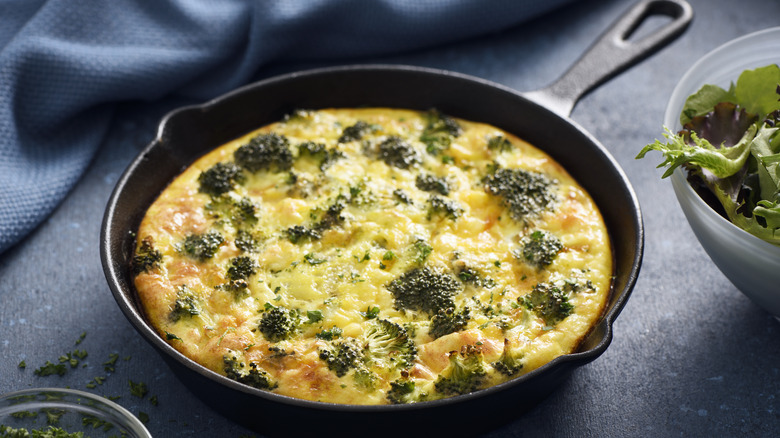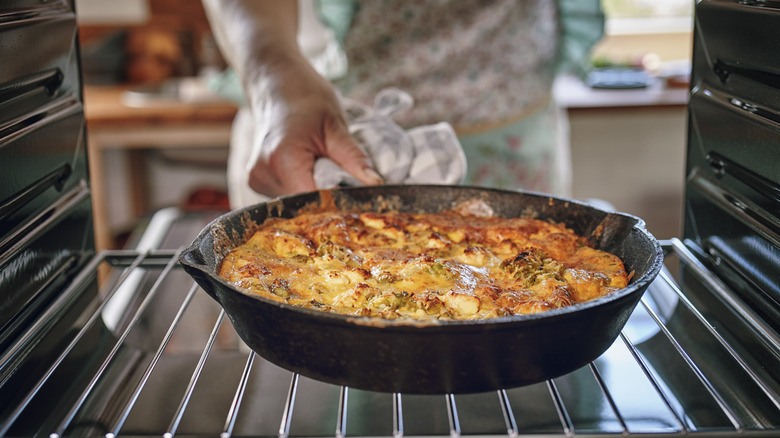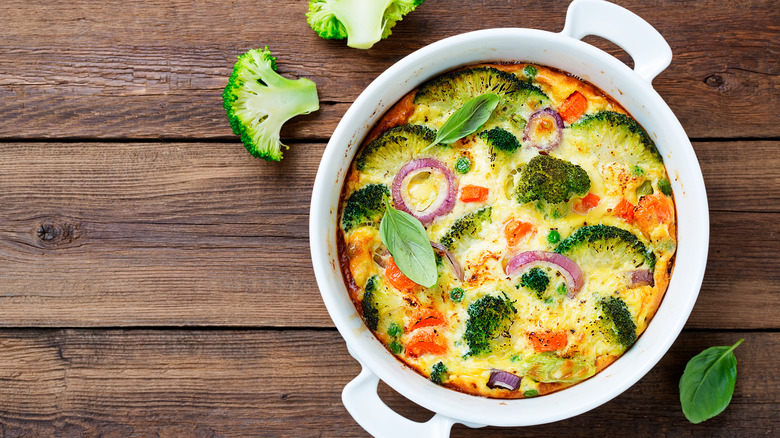Why A Cast Iron Skillet Is Key When It Comes To Homemade Frittatas
Frittatas are the perfect quick and easy recipe for a tasty weekend breakfast or weeknight meal. In fact, frittatas are not only healthy (because they are made from eggs, cheese, and veggies), but they are also a great way to use up random leftovers. Have extra stir-fried vegetables? Into the frittata. Leftover chicken? It's chicken frittata time. However, while frittatas are quite versatile when it comes to ingredients, surprisingly, the pan you use to cook a frittata is more limited and can make all the difference. For the best possible frittata, go with a cast iron.
The reason the cast iron skillet is the perfect choice for making a lovely frittata is that cast irons (when seasoned) are naturally nonstick, meaning you will easily be able to cut and remove slices of the egg pie to serve. Plus, even more importantly, cast irons are both stovetop and oven-safe. Most frittata recipes call for the egg and veggie mixture to start out on the stovetop and then finish in the oven — a regular pan with a rubber or plastic handle won't be up to this task.
Does using cast iron really make a difference?
Because cast iron cookware has gotten quite popular in recent years, you may have heard people swear by it. But you could also be wondering if cooking a frittata in a cast iron can really make that much of a difference. The answer is that while you can still make a delicious frittata in another pan, the cast iron takes it up to the next level. The main reason for this is that cast iron skillet heats dishes evenly and stays hot for a long time. This means the temperature of your pan won't drop when you add new ingredients, and all parts of your egg pie will cook evenly –- even the middle –- which is sometimes hard to cook properly when using other cookware.
Also, a seasoned cast iron skillet is nonstick without the extra chemicals like Teflon that are necessary to make regular pans nonstick. This means you will be able to get nice cooked edges on your frittata without having to worry about the egg mixture sticking to the bottom or sides. Of course, this only works in a seasoned skillet. So, if your cast iron is brand new, it probably won't have this nonstick quality.
Other ways to cook a frittata
If you don't have a cast iron skillet and don't plan on buying one anytime soon, there are a few other options you can try to make a frittata. One option is to make the frittata entirely in the oven in a casserole dish. This works quite well for instances when all your burners are occupied and you need to make one more dish that's a little more hands-off. Oven-baked frittatas will be slightly different than stove-first frittatas in that the bottom of the egg mixture won't have that delicious crust-like texture. This is because the bottom of a frittata usually crips up on the burner. However, an oven-only frittata will still taste great despite not having a crust that is quite as browned and crispy.
Just like you can make a frittata only using the oven, you can also make it entirely on the stovetop. The stovetop-only method allows you to use any nonstick frying pan you want to because you won't have to worry about it being oven-safe. The only thing to keep in mind when cooking a frittata on the stovetop is that you will need to flip it. This means you should chop up all ingredients as small as possible so that they won't cause your lovely frittata to tear or break while flipping.


